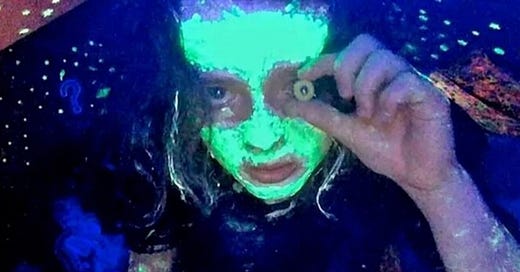We're All Going to the World's Fair
This unnerving spooker about a teen playing a haunted video game blurs genres and filmmaking techniques.
Every now and then, a movie comes along that doesn’t seem to belong to any specific genre or filmmaking tradition.
I remember watching “The Blair Witch Project” more than 20 years ago and thinking, ‘This is weird and new and different.’ It fell generally into the horror movie zone but used techniques and storytelling approaches from documentaries, rooted in a mythology that had been carefully built up on the then-nascent internet.
“We’re All Going to the World’s Fair” similarly feels like something very new yet tied to a deep well of scary-movie heritage.
It’s about a teenage girl playing an online video game that begins to invade her psyche and take over her life. The lines between her dreams/delusions and waking world grow blurred, and we fear she’s headed toward some terrible event… either as the victim, or perpetrator.
Now, we’ve seen these sorts of “the game becomes real” movies before — just last week, in fact, with the Netflix release of “Choose or Die.”
But this picture, written and directed by Jane Schoenbrun, takes things in a darker, and deeper, direction than easy scares and transitory mood shifts. It painstakingly builds a mood of paranoia and desperation, as Casey (Anna Cobb) starts playing the World’s Fair Game as a way to get attention or connect with others, and soon becomes its most ardent adherent.
It’s also interesting that the World’s Fair is not a traditional video game per se, but more an online community where (mostly young) people perform a ritual — repeating, “I want to go to the World’s Fair” three times along accompanied by a blood sacrifice — and then post videos reporting their experiences afterward.
We see a variety of these videos, some apparently real (or at least manufactured for the purposes of this movie), of other youngsters experiencing strange and disquieting effects. One woman believes that her body is starting to turn into a plastic doll. Others start wearing scary clown makeup, or devil’s horns, or grow odd skin rashes that seem to have… something… underneath.
What’s unnerving is that’s unclear if these are real-world events or something that’s just invented in their mind. People like Casey use their videos to share and spread their psychosis, but also to feel like they part of something — even if it’s a collective delusion.
She seems to be a normal, smart kid, maybe 15 or 16 years old, living in some unnamed American town. A bit withdrawn and unsure of herself, she spends much of her time in her attic bedroom on her computer, making or watching videos.
Most of the movie is shots of Casey as seen from her webcam, though she makes a few excursions outdoors. It’s winter and she doesn’t seem to have any friends, and the only intrusion from any parents is her dad banging on the floor about the noise she’s making late at night.
Later, Casey begins exchanging video messages with JLB, a mysterious veteran of the game who advises her and worries that she’s getting in too deep. Eventually they connect for a video chat, although all JLB (Michael J Rogers) shares of himself is a horrifying drawing of a shrieking figure.
He’s apparently an older man, and although his attention seems benevolent, our mind immediately goes to terrible real-life abuse and exploitation of minors that happens all the time on the web. Is JLB really a friend, just a lurker, or something more threatening?
Schoenbrun uses unusual imagery and camera work, a mix of cinema verite, home video and mobile devices. There are moments where I wasn’t quite sure what was happening or how to feel, such as when Casey breaks into a strange song/dance about the cold winter she’s experiencing, and we’re not sure if we’re supposed to laugh, or if another terrifying moment hangs just around the corner.
How exhilirating, to find the only thing you can expect is the unexpected.
“We’re All Going to the World’s Fair” genuinely left me deeply unsettled. It’s a harrowing portrait of the sort of lonely lives a lot of people have been experiencing the last couple of years, which they attempt to address with a faux reflection of a community constructed online.
But how much of what we see there is real, how much a deception, and how much a projection of our own darkest fears?
This movie sometimes seems less like scary fiction than a manifestation of the anxiety that comes with our brave new (dis)connected world.




![We're All Going to the World's Fair [Review] - Wicked Horror We're All Going to the World's Fair [Review] - Wicked Horror](https://substackcdn.com/image/fetch/$s_!emWk!,w_1456,c_limit,f_auto,q_auto:good,fl_progressive:steep/https%3A%2F%2Fbucketeer-e05bbc84-baa3-437e-9518-adb32be77984.s3.amazonaws.com%2Fpublic%2Fimages%2F8c28350f-34a5-4f34-8bcf-54263a4ef504_1280x720.jpeg)
